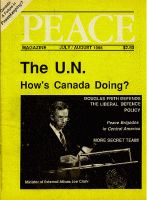
Peace Magazine Aug-Sep 1988, page 30. Some rights reserved.
Search for other articles by David Kattenburg here
A travelogue of the Maritime peace movement
Last winter Ed Reese and I drove to the Maritimes to conduct interviews with members of the peace movement for a series of radio documentaries on peace and conflict.
Our first stop was Saint John, New Brunswick. What an amazing feeling to meet with a group of Saint John activists on the top floor of the Market Square shopping mall, where the Saint John Project Ploughshares has its resource centre!
Ploughshare members are concerned over the infiltration of defence industries in the region, a recurring theme throughout our journey to the Atlantic provinces. The major culprit in Saint John is the shipyards and drydocks. The Patrol Frigate Program has brought many jobs to the area. While the Saint John Shipbuilding company has a "long and honorable history," and the patrol frigates may serve a legitimate role for non-provocative coastal defence, the Saint John group wonders where the shipyards will move next. Already there has been talk of future submarine work at the shipyards. "What offends me, is people will not be able to choose jobs," says Judith Meinert."You offer them a job that is like 'digging your own grave'...I think it's immoral and irresponsible to put people in that position."
From Saint John we drove to Fredericton. Six of us met at Conserver House for a discussion of local and national issues. Once again, the militarization of the Maritimes was the major concern. The peace and labor movements must work together, say Jessie Davis and veteran peace activist Jim Bedell, in order to establish a program for both industrial conversion and economic democracy.
Upon arriving in Halifax we met with Larry Fisk, a peace educator at Mount Saint Vincent University, and with Giff Gifford and friends at the office of Veterans Against Nuclear Arms. We also met with Valerie and John Osborne of Dartmouth. The Osbornes are veteran sub watchers. Conscious of the fact that ballistic missile firing submarines were entering their harbor, the two began keeping track of these activities. "In Halifax, if you're looking, you can see these things," says John. "They're not so theoretical as they would be in Toronto. So we have tried to use them to start an educational process...to say what they are capable of."
We met with Donald Craig, the editor of the Nova Scotia Peace Networker, a newsletter about local and provincial activities of interest to the peace community. He explained how the local nuclear weapons-free movement was started by a group of enterprising high school students, and how since that time more people are taking a greater interest in the defence contracts that are coming into the region.
The next stage of the trip was a marathon drive to Newfoundland.There we drove the long arc across Newfoundland. In St. John's I met with Allison Dyer of the Peace Centre, Geoff Carre-- who publishes a newsletter on NATO jet fighter and weapons training in Labrador and Quebec-- and Peter Armitage.
"The NATO powers are on the verge of rendering the Quebec-Labrador peninsula uninhabitable," Armitage says. Years of work in cooperation with native Innu people leads him to conclude that the Dutch, Belgian, British, and West German air forces are practicing nuclear-related aerial maneouvres. These and other exercises, particularly low-level flight training, are contributing to the collapse of Innu culture. "We're not satisfied with taking away their land," says Armitage. "Now we are taking away their peace of mind."
Armitage is preparing a submission to the Federal Environmental Assessment Review Office, in order to bolster Innu demands that the testing, as well as the establishment of a full-fledgedNATO training base in Goose Bay be stopped. "It's the small peoples who always suffer from this sort of military training. I think it's immoral if not unconstitutional to do to the few what is unacceptable to the many."
On our way back through Nova Scotia we stopped off in Wolfville to speak with Peggy Hope-Simpson, who feels the White Paper on Defence is a frightful "cold war" document. "I think Mr. Beatty is out of step with what's going on in this country." she says.
Hope-Simpson is a peace elder with the Quaker Church. She believes the peace movement needs a spiritual base in order to survive. "We all start off with a little spark of the divine, and it's there to be nurtured. We must respect that bit of divinity in others.You don't kill the sacred principle of life."
The last stop on our tour of the Maritimes was with Donna Smyth, who teaches English at Acadia University, and is author of Subversive Elements. The book is largely about the experience of Smyth's opposition to the presence of uranium prospectors in Nova Scotia.
The episode was an exercise in how to organize locally, deal with the media, and use humor to silence the opposition. During the uranium inquiry, which culminated in a prospecting moratorium, Smyth and her cohorts staged some animal theatre in the courtroom. "Mrs. Midnight's Animal Farm" featured a piglet, a chick, a lamb, and a goat. The highlight of their brief sketch was a bit of animal doggerel to the tune of the Little Brown Jug, "Keep us animals safe from harm, down on Mrs. Midnight's farm. We're not really half so dumb, we know we don't need no uranium!"
Assured the peace movement was alive and kicking in the Maritimes, we returned to Hamilton with a small mountain of tape to incorporate into the Peace and Conflict Radio Project, which is heard on college radio stations across the country.

Peace Magazine Aug-Sep 1988, page 30. Some rights reserved.
Search for other articles by David Kattenburg here